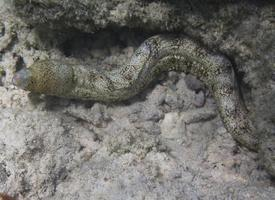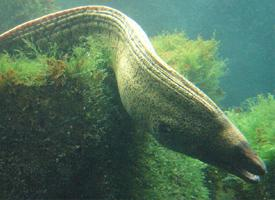
Greutăți și măsuri
| Lungime | 1 m |
|---|
Starea de conservare
| Amenințat |
Descrierea animalului
The Snowflake Moray, scientifically known as Echidna nebulosa, is a captivating marine creature that belongs to the family Muraenidae. This species of eel is widely admired for its distinctive and attractive appearance, which makes it a popular choice among aquarium enthusiasts. Originating from the warm, tropical, and subtropical waters of the Indo-Pacific region, the Snowflake Moray has adapted to a variety of marine environments, including coral reefs, lagoons, and rocky coastal areas.Characterized by its elongated, snake-like body, the Snowflake Moray can reach lengths of up to 100 centimeters, though most specimens are smaller, typically around 60 centimeters. The body of this eel is covered in a thick, mucus-coated skin instead of scales, which helps to protect it from parasites and infections. Its skin displays a stunning pattern of black spots and blotches on a white to creamy-yellow background, reminiscent of snowflakes, hence its common name. This striking pattern not only provides the Snowflake Moray with an eye-catching appearance but also serves as an effective camouflage, helping it to blend in with its coral reef surroundings and evade predators.
The Snowflake Moray has a large, gaping mouth equipped with sharp, backward-facing teeth. These teeth are specially adapted for grasping and holding onto slippery prey, such as fish and cephalopods. Unlike most fish, the Snowflake Moray lacks pelvic and pectoral fins, relying instead on the undulating movements of its body and tail to propel itself through the water.
This species exhibits a nocturnal lifestyle, spending most of the daylight hours hidden within crevices and caves of the reef. It emerges at night to hunt, using its keen sense of smell to locate prey. The Snowflake Moray is a solitary creature, with individuals only coming together for the purpose of breeding. Reproduction in this species involves the release of eggs and sperm into the water, where fertilization occurs externally. The larvae that emerge are planktonic, drifting with the ocean currents until they are large enough to settle on the reef and begin their benthic life.
In terms of diet, the Snowflake Moray is carnivorous, feeding on a variety of marine animals. In the wild, its diet primarily consists of smaller fish, crustaceans, and cephalopods. In captivity, however, they can be fed a diet of fish, squid, and shrimp. Care must be taken when feeding these eels, as their poor eyesight and aggressive feeding response can sometimes lead to accidental bites.
Despite their fierce appearance and solitary nature, Snowflake Morays are relatively shy and reclusive, posing little threat to humans unless provoked or threatened. However, their adaptability, combined with their striking appearance, has made them a subject of interest not only for marine biologists but also for those involved in the aquarium trade.
Conservation-wise, the Snowflake Moray is currently not considered endangered, thanks to its wide distribution and adaptability to different marine environments. However, like many marine species, it faces threats from habitat destruction, pollution, and the impacts of climate change on coral reefs. Ensuring the health and sustainability of coral reef ecosystems is crucial for the preservation of this unique and fascinating species.
Animale similare
Fotografii noi cu animale
Top 10 animale
- Dolphin gull (Leucophaeus scoresbii)
- Diana monkey (Cercopithecus diana)
- Galápagos tortoise (Geochelone nigra complex)
- Moustached guenon (Cercopithecus cephus)
- Japanese spider crab (Macrocheira kaempferi)
- Colossal squid (Mesonychoteuthis hamiltoni)
- Stone loach (Barbatula barbatula)
- Fox tapeworm (Echinococcus multilocularis)
- Japanese macaque (Macaca fuscata)
- Barbary macaque (Macaca sylvanus)
